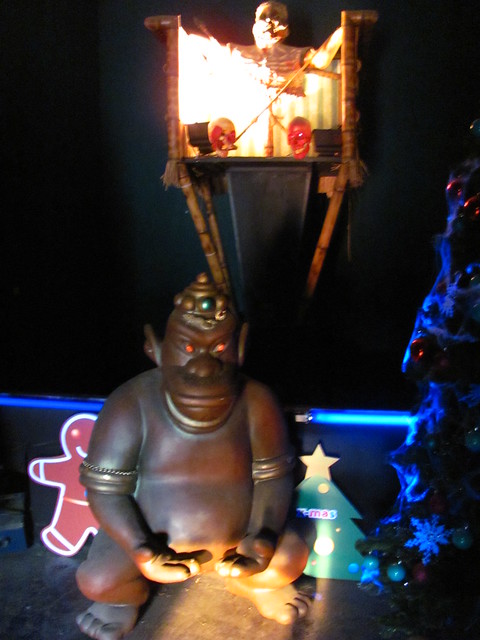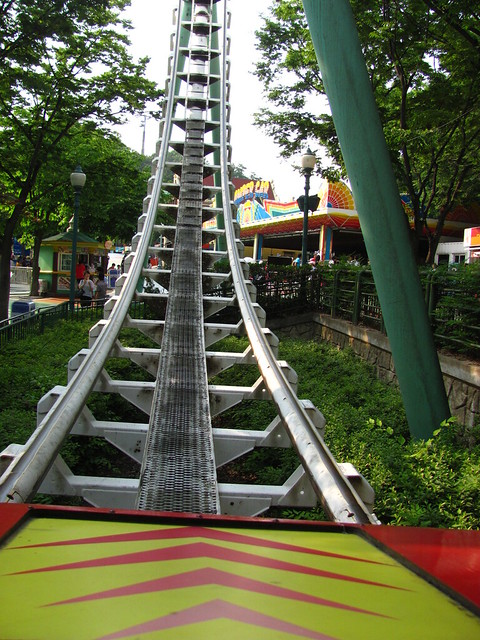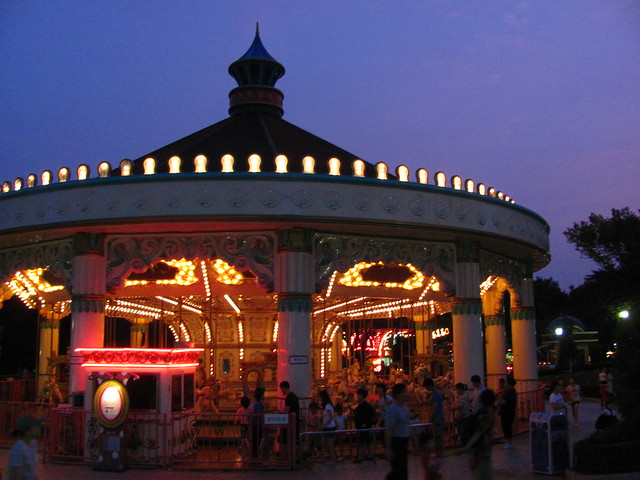Daegu, South Korea – Saturday, June 11th, 2011
I arrived in Daegu around 4:00pm, ready to spend a couple of evening hours at the city’s Woobang Towerland amusement park (since renamed as “E-World”). The park is situated on the Duryu hill in Daegu, where a 200+ meter observation tower atop the hill gives the park its original, somewhat unusual name. To go up the observation tower is an extra cost, and regardless I had plenty to do in the couple of hours I had in the amusement park.
To get to the park, a ride on a cable car gondola is required. While not going nearly as high as the tower, it still had the benefit of giving an aerial view of the entire park upon arrival. This was especially helpful to plot the layout of the park.
Similar to Kumdori Land which I visited earlier that day, Woobang Towerland was built all at the same time in the mid 90’s (in this case 1995) and has apparently seen very little change or growth since. But unlike Kumdori Land, Woobang Towerland was doing reasonably strong business this Saturday evening, with many of the locals turning out to give the place a lively atmosphere. Although the park was built in 1995, the particular collection of rides would seemingly suggest a slightly older park, perhaps of 1980’s vintage. (It’s likely the park planners were simply behind the industry trends by several years when they got around to procuring their hardware.) Plus, the plentiful mature trees sheltering the pathways and concealing many of the attractions from the midway also hinted at a longer-lived park than its 16 year age (at the time) revealed. Absolutely no complaints, just surprised.
The first section I came across was the children’s zone, so I opted to start with my chore list there.
My first ride was Magic Castle, a unique creation by EOS featuring a spiraling lift hill. Supposedly a combination of powered coaster and dark ride, the simple layout (consisting of only right turns and a single descending ramp after the spiral lift, with a single dark, empty room at the bottom) doesn’t offer much of either coaster or dark ride qualities, but feels more like an attempt to plus up one of those carnival kid’s convoy rides (the kind with the spiral ramps).
Still, it was very different from any other children’s coaster I had seen, which is worth something.
Woobang Towerland features not one but two steel looping coasters. The first one, called Hurricane, appeared to be an Arrow Loop Corkscrew model, although a few minor differences in design suggested a copy from perhaps a Japanese manufacturer. The official manufacturer is unknown.
The ride was hard to photograph and to locate the entrance, being situated along a densely forested hillside. This also led it to being the least popular coaster I would encounter, although the rough ride it gives may have had some impact on its reputation among the locals.
The other looping coaster is a Vekoma Boomerang, predictably named Boomerang. I managed to grab a front seat ride.
The ride itself was quite predictable as well, although as the only Vekoma Boomerang to be found in Korea (or nearby Japan for that matter) it earns some points for being the only one of its kind to find its way to this corner of the world.
The last coaster on my list was showing a longer wait, so I opted to explore the rest of Woobang Towerland for a bit and come back closer to park closing time. Various flat rides can be found throughout the park…
…although the only one I had to try for myself was their Tagada-style ride, called Tambourine. The premise of this ride is that everyone sits in a large inward-facing ring, which then spins and bounces. The catch: there are no restraints or seat dividers. The result is like one of those crazy people mixers they used to build in places like Coney Island before safety standards were established for rides, yet somehow the Tagada has slipped through in a few places around the world.
This was actually my second Tagada, after trying one at the Wiener Prater in Vienna the year before. This one was even better, for the sole reason that the Prater Tagada I only rode with a couple of other people, while the Woobang Towerland Tambourine was fully loaded. Even if the program was a bit tamer, it still made it harder to hold on when everyone else is reaching for the same points of grip.
A more Korea-specific oddity was the grass sledding hill. I had seen these at a couple of parks, but finally decided to give it a try for myself.
Grab a sled, walk the ramp to the top, then slide down. Just like winter sledding, only with a bit more friction and the added challenge of avoiding the water sprinklers or random puddles on the way down. I may have ended up with a slightly soggy bottom at the bottom, but at least I can say I tried it.
I would not, upon consideration, be attempting the giant floating hamster balls as well.
Ghost House. I honestly do not remember anything about this, even if I did it at all.
But I do have this photo apparently taken inside. Is that a cursed bronze monkey god being raised by the voodoo spirits as a Christmas tree gift? I try my best to reassemble the narrative based on nearly ten years of fuzzy memories and various online resources, but this one I am left completely confounded by.
 Speaking of silly things, every Asian amusement park should have an amusing homemade interpretation of an internationally recognized IP, and Woobang Towerland was no exception.
Speaking of silly things, every Asian amusement park should have an amusing homemade interpretation of an internationally recognized IP, and Woobang Towerland was no exception.
The sun was beginning to hang low in the sky. Time to head to my final coaster for the evening.
Camel Back is a Meisho Amusement Machines coaster. While it features no inversions along its basic out-and-back/figure-eight style layout, this coaster built along the hillside at Woobang Towerland is easily the star attraction found at this park.
Camel Back rides quite a bit like a well-maintained traditional wooden coaster, focusing on the uncomplicated pleasures of simple but decently sized drops and curves with minimal restraints. The real pleasure, however, was the wooded hillside setting, which provided some great flyby effects combined with the shadows from the yellow spotlighting, and could often obscure the upcoming track from view. While very Asian in identity, Camel Back very much felt like a throwback to the kind of experience you’d expect at a wooded regional American park like Knoebels.
I only got one ride in the front row, but very much wish the queue would have given me time for more. There was clearly a reason why this was the most popular coaster in the park.
I was pleasantly surprised by Woobang Towerland. Rides like Camel Back and Tambourine certainly made the visit worthwhile, and with two full-sized looping coasters and a decent collection of other flat rides, the park stealthily maintains one of the better overall ride collections in South Korea. Even the kiddie coaster is a weird treat in its own right. But with the sun now set and the park closed, it was time to head back to the train station for the final leg of my trip to Gyeongju for one last full day of roller coasters and cultural discovery in Korea.

























































Comments